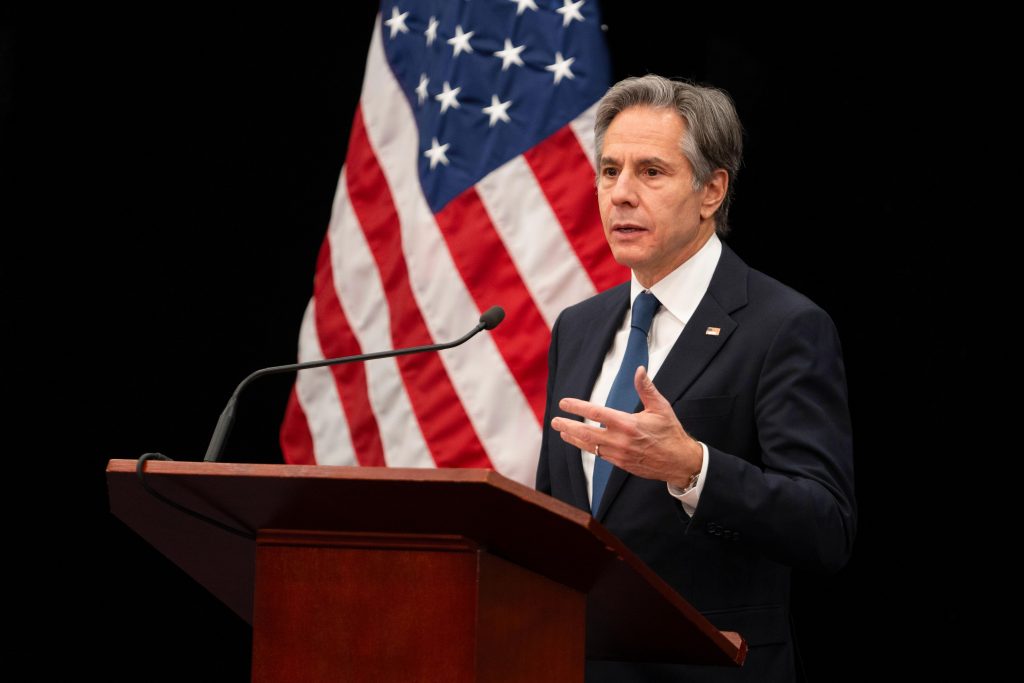Tensions over Russia’s military buildup near Ukraine rose sharply as the United States and its allies rejected Moscow’s assertions that it was pulling back forces and they issued new predictions that the Kremlin would launch an attack on its ex-Soviet neighbour within days.
Russia said the withdrawals were proceeding and repeated its denials that it had no intention of embarking on an incursion into Ukraine. Moscow also expelled a senior U.S. diplomat in retaliation for a similar action by Washington.
Ukraine decried the shelling of a school from a part of the country held by armed Russian proxies as a provocation. Western leaders suggested the action was planned as a pretext for Moscow to press on with a move into Ukrainian territory.
Tens of thousands of Russian troops remain deployed on Ukraine’s borders eight years after Russia annexed the Crimean peninsula and fomented an uprising by proxies in eastern Ukraine. Kremlin leader Vladimir Putin has kept pressing Moscow’s demands for “security guarantees” from the West, including an undertaking that NATO would expand no further and Ukraine would never become a member.
U.S. Secretary of State Antony Blinken, in a surprise and dramatic appearance at a U.N. Security Council session, said intelligence pointed to a Russian advance into Ukraine in the “the coming days” and challenged Moscow to demonstrate that no incursion would occur by sending the troops back to base.
Blinken demands clarification from Moscow
“The Russian government can announce today with no qualification, equivocation or deflection that Russia will not invade Ukraine. State it clearly, state it plainly to the world,” Blinken told the sitting. “And then demonstrate it by sending your troops, your tanks, your planes back to their barracks and hangars, and sending your diplomats to the negotiating table…In the coming days, the world will remember that commitment, or the refusal to make it.”
Blinken laid out a scenario of a Russian attack launched with missiles and bombs along with multiple cyber attacks and then an advance by soldiers and tanks. He accused Russia of planning a “false-flag operation” – an attack camouflaged to appear it originated from elsewhere – to justify military intervention.
Blinken said he had requested a new meeting with Russian Foreign Minister Sergei Lavrov – and indicated that Washington had received Russia’s latest message in back-and-forth communications over Moscow’s call to redraw security arrangements in Europe.
U.S. President Joe Biden restated the notion of an imminent Russian attack.
“Every indication we have is they’re prepared to go into Ukraine,” he said outside the White House. But he added that “there is a path” to a diplomatic resolution.
At the Security Council, Russia Deputy Foreign Minister Sergei Vershinin described as “dangerous” the scenario depicted by Blinken and complained that Ukraine was doing nothing to implement the “Minsk accords” – two agreements aimed at resolving the conflict in eastern Ukraine, signed in 2014 when authorities in Kyiv were under considerable military pressure.
In remarks later to reporters, Vershinin called on Western countries to “drop and to stop this hysteria about the intentions of Russia in the region”, and reiterated Moscow’s announcement that after military drills Russian troops would return to their bases in Russia. Russia has for the past three days said some troops were being withdrawn and showed video footage with tanks being loaded on trains.
But Western leaders – including participants in a NATO meeting on Wednesday – rejected the Russian statements and cited satellite photos as evidence that troops were being drawn closer to the border.
Upsurge of military activity along line separating Ukrainian army, separatists
The shelling of the school in the Ukrainian town of Stanitsya Luhanska was part of an upsurge in military activity along a line separating Ukrainian troops and the separatists aligned with Moscow. Three adults – but no children — were injured and a hole was blown through a wall. Such incidents have been relatively common along the line separating the two sides, but tensions were clearly running high.
The separatists accused Ukrainian forces of violating a cease-fire in the region and the Kremlin repeated long-held statements that Ukraine was massing troops in the area.
The separatists run two “people’s republics” in eastern Ukraine – these have no international recognition, but the lower house of Russia’s parliament urged Putin this week to extend that recognition from Moscow.
Ukrainian President Volodymyr Zelensky accused the Russian side of “provocative shelling”.
British Prime Minister Boris Johnson said the incident was a prime example of the sort of “false-flag operation” that Russia might take to justify its own military activity.
Diplomatic forays have been undertaken to Moscow and Kyiv in recent days and weeks to try to ease tension and create conditions for a settlement of the key issues.
German Chancellor Olaf Sholz met Putin and Zelensky this week as did French President Emmanuel Macron a week ago.
France has been the prime force behind efforts to focus on the Minsk accords to end the troop buildup and promote a settlement in the region through a process known as the “Normandy format”, including France, Germany, Russia and Ukraine.
The Minsk accords provide for a degree of autonomy to be given to areas now held by the separatists and elections to be held, with Ukrainian reasserting control over its formal border with Russia. But many in Ukraine see the agreements as a betrayal of the country’s interests and the thin end of the wedge giving Russia control over Ukrainian public policy.
Extending recognition to the two separatist statelets would almost certainly imperil talks aimed at implementing the Minsk agreements.
Zelensky has urged Western countries to tone down talk of an invasion, saying it only served to sow panic and authorities were prepared for all eventualities. The country staged a “Day of Unity” on Wednesday, with displays of patriotism, to show its resolve in the light of the military buildup and the discussion of a possible incursion.

